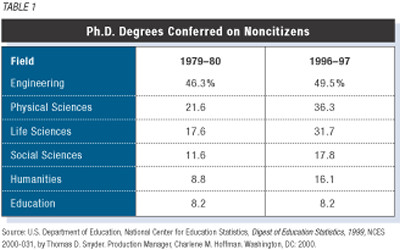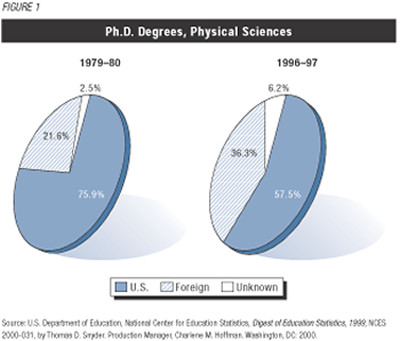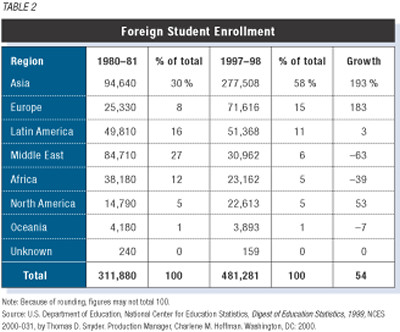- Education
In the United States, educational excellence has always been

important. Many consider it a barometer for determining the vibrancy and health of our nation and an indicator of potential economic growth and development. In 1989, for example, the nation’s governors set a goal that U.S. students be first in the world in math and science by the turn of the century; in 1994, Congress enacted the Goals 2000: Educate America Act, which set the same goal. This goal was not achieved. Moreover, according to then–secretary of education Richard W. Riley, "American children continue to learn, but their peers in other countries are learning at a higher rate."
The results of the recently released Third International Math and Science Study (TIMSS)-Repeat are discouraging. This 1999 follow-up study to the first TIMSS tested the same fourth-grade cohort that previously had done well in international comparisons, scoring in the top 25 percent in 1995. By 1999, as eighth graders, these students had dropped dramatically in their rankings, confirming that the longer U.S. students stay in school, the farther behind they fall in math and science. The only American group that showed improvement since the 1995 survey were African American students, whose achievement rose in math but not science.
|
"The longer American students stay in school, the farther behind in math and science they fall." |
These shortcomings in our elementary and secondary school educational system affect higher education as well. For example, the five highest performers in eighth-grade mathematics in the TIMSS-Repeat were Asian—Singapore, Korea, China, Hong Kong, and Japan. In science, four out of the top five were Asian—China, Singapore, Japan, and Korea. Not surprisingly, then, the highest percentage of foreign students enrolled in institutions of higher education in the United States is Asian. Furthermore, the percentage of Asian students has grown as a percentage of foreign enrollment from 30.3 percent in the 1980–81 school year to 57.7 percent in the 1997–98 school year.
In the United States, the number of bachelor’s, master’s, and doctoral degrees awarded to U.S. citizens compared to non-U.S. citizens in science and math has decreased over time. In the 1979–80 school year, for example, out of the total number of Ph.D. degrees conferred in the physical sciences, U.S. students received nearly 76 percent and foreign students received nearly 22 percent. (The percentages do not equal 100 because some students’ citizenship status is unknown.) In the 1996–97 school year, 57.5 percent of doctoral degrees in physical sciences were conferred on U.S. citizens versus 36.3 percent on foreign citizens. Furthermore, in that same year, of those receiving Ph.D.’s in mathematics and engineering, only 46.2 and 44.3 percent, respectively, were U.S. citizens whereas 46.6 and 49.5 percent were students with visas. In both these highly technical fields, there are now more noncitizens than U.S. citizens receiving Ph.D.’s (see table 1 and figure 1).


The number of foreign students enrolled in institutions of higher education in the United States continues to grow at the undergraduate as well as at the graduate level. In 1980, some 311,880 foreign students were enrolled in higher institutions of learning in the United States, 2.3 percent of the total enrollment. In the 1997–98 school year, a total of 481,281 foreign students were enrolled, 3.4 percent of enrollment in institutions of higher learning, an increase of 54 percent. Most of the growth came from two regions, Asia and Europe, both of which nearly tripled in size; enrollment of students from Middle East countries fell by more than half (see table 2).

The United States’ postsecondary education is still considered the best in the world, but its elementary and secondary education is slipping in international rankings. Although the United States has benefited in many ways from the influx of foreign students when they participate in the society and contribute to economic growth, they don’t all stay. And those who choose to stay may not do so for their entire lifetime. In 1995, for example, only 53.6 percent of foreign doctoral recipients stayed in the United States.
|
"In some fields, American universities are now awarding more doctorates to noncitizens than citizens." |
As the world economy becomes more globalized, the United States has become increasingly dependent on the skills of the international students who gain advanced degrees in the hard sciences. But if many of these foreigners choose to return to their home countries, we will effectively be training and filling the ranks of our competitors. The ramifications of poor achievement in elementary and secondary schools extend far beyond 12th grade.
















